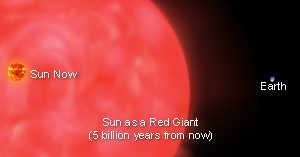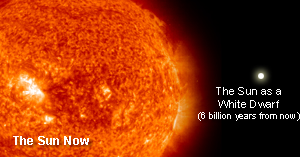White dwarfs are among the dimmest stars in the universe. Even so, they have commanded the attention of astronomers ever since the first white dwarf was observed by optical telescopes in the middle of the 19th century. One reason for this interest is that white dwarfs represent an intriguing state of matter; another reason is that most stars, including our Sun, will become white dwarfs when they reach their final, burnt-out collapsed state.

A star experiences an energy crisis and its core collapses when the star's basic, non-renewable energy source - hydrogen - is used up. A shell of hydrogen on the edge of the collapsed core will be compressed and heated. The nuclear fusion of the hydrogen in the shell will produce a new surge of power that will cause the outer layers of the star to expand until it has a diameter a hundred times its present value. This is called the "red giant" phase of a star's existence.

A composite image of the Cat's Eye from Chandra (purple) and HST (red & green) shows where the hot, X-ray emitting gas appears in relation to the cooler material seen in optical wavelengths.
A hundred million years after the red giant phase all of the star's available energy resources will be used up. The exhausted red giant will puff off its outer layer leaving behind a hot core. This hot core is called a Wolf-Rayet type star after the astronomers who first identified these objects. This star has a surface temperature of about 50,000 degrees Celsius and is furiously boiling off its outer layers in a "fast" wind traveling 6 million kilometers per hour.
The radiation from the hot star heats the slowly moving red giant atmosphere and creates a complex and graceful filamentary shell called a planetary nebula (so called because it looks like the disk of a planet when viewed with a small telescope). X-ray images reveal clouds of multimillion degree gas that have been compressed and heated by the fast stellar wind. Eventually the central star will collapse to form a white dwarf star.
In the white dwarf state, all the material contained in the star, minus the amount blown off in the red giant phase, will be packed into a volume one millionth the size of the original star. An object the size of an olive made of this material would have the same mass as an automobile! For a billion or so years after a star collapses to form a white dwarf, it is "white" hot with surface temperatures of about twenty thousand degrees Celsius.

When they were first discovered, white dwarfs presented a paradox to astronomers. If a white dwarf couldn't produce energy through nuclear fusion, how could it generate the pressure necessary to keep it from collapsing further? It didn't seem possible, yet there they were, glowing dimly and reminding scientists that "the fault is not in the stars, but in their theories," to paraphrase Shakespeare.
The paradox was not resolved until the quantum theory of matter was developed in the 1920s. This theory showed that matter in so-called "degenerate" states of extremely high density could produce a new type of pressure never observed in a terrestrial laboratory. This is because the quantum theory prohibits more than one electron from occupying the same energy state.

To see how this works, think about a parking lot. Only one car is allowed per space. When there are many empty spaces, there is very little motion in the parking lot. As an occasional car enters the lot it is quickly parked. When the parking lot is full, however, the picture changes. There is continual motion as cars move from one row to another while drivers search for a space. The pressure builds to get into position whenever a space is opened up.

Extremely dense matter is like a crowded parking lot. All of the low energy "parking spaces" are taken, so electrons are forced into higher energy states, not because they are hot, but because there is nowhere else to go. This creates a "degenerate" electron pressure (degenerate refers, not to the moral character of the electrons, but to the fact that all the low energy states are occupied). This pressure is what prevents white dwarf stars from collapsing under their own weight.

Chandrasekhar
Limit
While still in his twenties Subrahmanyan Chandrasekhar, the Chandra X-ray
Observatory's namesake, used relativity theory
and quantum mechanics to show that degenerate electron pressure can do only so
much. If the mass of the white dwarf becomes greater than about 1.4 times the
mass of the Sun—called the Chandrasekhar limit—it will collapse. In a
binary star
system this could happen if a nearby companion star dumps enough material
onto a white dwarf to push it over the Chandrasekhar limit. The resulting
collapse and explosion of the white dwarf is believed to be responsible for the
so-called Type Ia
supernovas.
Observations of white dwarfs are difficult because they cool quickly and become dim. When they are very young and hot their surfaces can produce X-rays. On these rare occasions X-ray telescopes provide valuable information about the nature of a newly formed white dwarf.
Fortunately, there are other possible conditions that allow astronomers to observe X-rays from a white dwarf. These opportunities occur when a white dwarf is capturing matter from a nearby companion star. As captured matter falls onto the surface of the white dwarf, it accelerates and gains energy. This energy goes into heating gas on or just above the surface of the white dwarf to temperatures of several million degrees. The hot gas glows brightly in X-rays.
A careful analysis of this process can reveal the mass of the white dwarf, its rate of rotation and the rate at which matter is falling onto it. In some cases, the matter that accumulates on the surface can become so hot and dense that nuclear reactions occur. When that happens, the white dwarf suddenly becomes 10,000 times brighter as the explosive outer layers are blown away in what is called a nova outburst. After a month or so, the excitement is over and the cycle begins anew.
To think of a white dwarf as a "burned out" or "dead" star can be misleading. It is more like a transformation or metamorphosis from one stage to the next. As X-ray observations prove, under the right conditions an old star can be quite lively indeed.




